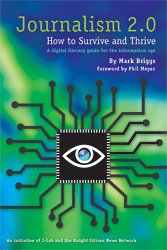
*This chapter was very insightful in providing me with the necessary steps to be a successful journalist in the every changing news reporting industry.*
The chapter itself revolves around the words of Phil Meyer in his book, “The New Precision Journalism,” where he exclaims, ““If you are a journalist, or thinking of becoming one, you may have already noticed this: They are raising the ante on what it takes to be a journalist.“1
As the days of dominant newspaper circulation and increased advertising revenue slowly dimmers away, editor and reporters are being asked to do more to alter the trend. Brigg’s explains that editors and reporters must embrace technology and use the power of the people to help with your reporting legwork. It will only make newsgathering much more efficient if you can jump start the process of finding background, data, sources and experts. Brigg’s highlights how reporters need to become as efficient as possible. They can accomplish this through the use of technology and a more open approach to gathering information, reporters, photographers and editors can elevate their talent for newsgathering and news judgment without sacrificing their values. Capturing keystrokes to build useful databases and using new reporting methods such as crowdsourcing and distributed reporting are becoming the focus for more and more U.S. newsrooms.
The main point of this chapter is if you cut through the rhetoric you’ll find unprecedented opportunities to do better journalism by embracing technology and transparency; two essential qualities for amplifying the important work of journalism in the digital age.
Crowdsourcing: is a relatively new term, coined by Jeff Howe in a 2006 article for Wired News. Think of crowdsourcing like outsourcing, the term from which it was born. The focus of crowdsourcing is usually ongoing production of information while distributed reporting relates more closely to a specific and fixed-time project, such as answering a specific question or reporting on a specific subject.
Distributed, Collabrative, or open-source reporting: is a form of transparency for a news organization. Traditionally, readers only learn about stories a news organization is working on when the articles are finished and published. While it is customary to keep a story idea secret to prevent the competition from running with the idea, the distributed reporting model requires a news organization to go public with a story idea early in the reporting process.
1 Philip Meyer, The New Precision Journalism, 2nd Ed., Indiana University Press, 1991.

No Comments so far ↓
There are no comments yet...Kick things off by filling out the form below.